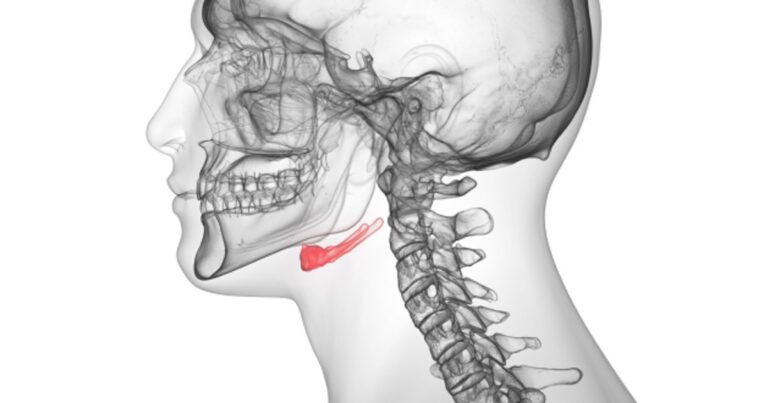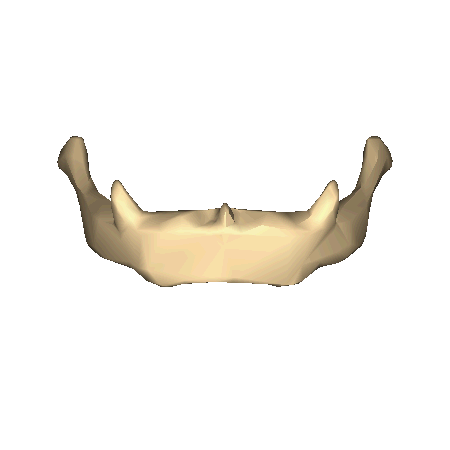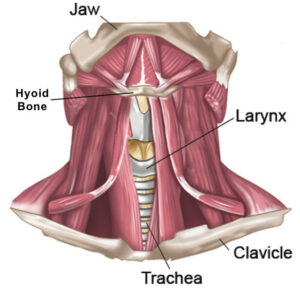BAST’s Alexa Terry takes a closer look at the hyoid bone, otherwise known as ‘the singing bone’.
“Clarifying, understanding and organising oneself around the hyoid bone… has amazing and profound effects on many things within the vocal mechanism, but also within the whole self. It’s related to your breathing, it’s related to your standing, it’s related to almost everything.” Robert Sussuma.
The hyoid bone (sometimes referred to as “the singing bone”) is a structure found in the front of the throat, above the larynx but below the chin. Uniquely, it is the only bone in the body that doesn’t directly articulate with another bone. Instead, it is suspended by surrounding muscles and ligaments; the pharynx’s own floating Buddha.
Medically speaking, the hyoid bone is not regarded as part of the larynx. However, in vocal anatomy and voice production, it is an important part to consider.
What does it look like?
The hyoid bone is horseshoe-shaped (although, to me, it wouldn’t look out of place mounted on the wall of an old house next to a creepy taxidermy stag). It consists of:
- The Body – the front.
- Lesser Horns – two small spikes at the top of the body which point upwards and back.
- Greater Horns – two arms which run out from the body and point backwards to create the U-shape.
“You can find the hyoid at the junction of the anterior surface of the throat (vertical) and the underside of the chin (horizontal). Palpate it using your thumb and the index finger, just above the thyroid cartilage.” (Anatomy of Voice by Blandine Calais-Germain and Francois Germain.)
What is its function?
Primarily, the hyoid bone:
- Acts as a point of attachment for muscles of the tongue and neck.
- Is thought to help keep the airways open which comes in handy when sleeping, except in cases of sleep apnoea. “The hyoid bone is free to move around somewhat instead of being firmly anchored in position,” says otolaryngology professor and “sleep doctor” Eric J. Kezirian. “The mobility of the hyoid bone may allow the structures that attach to it to collapse and cause airway blockage during sleep.” (Read more here.)
Relationship between the hyoid bone and the larynx
The larynx hangs from the hyoid bone and, like its bony friend, is held in suspension by a scaffolding of muscle. The extrinsic laryngeal muscles found on the outside of the larynx serve to raise and lower it for actions like swallowing and yawning, and some of these muscles (also known as the suprahyoid and infrahyoid muscles), have contact points with the hyoid bone. Therefore, any action which elevates or depresses the hyoid bone will impact the height and mobility of the larynx.
The suprahyoids (raising) include:
- Digastric
- Stylohyoid
- Geniohyoid
- Mylohyoid
Together, these muscles are responsible for supporting the tongue and its movements, raising the hyoid bone, and lowering the jaw, and are found above the hyoid bone. The suprahyoid muscles are considered the stronger set (if they were an Avenger, they’d be Thor), as they’re involved in the primary function of the larynx, which is to raise for swallowing in order to protect the windpipe from our crisps (Doritos, please) and Nando’s (I’m a mango and lime girl).
The infrahyoids (lowering) include:
- Sternohyoid
- Thyrohyoid
- Omohyoid
Together, these muscles are responsible for lowering the hyoid bone and lowering/lifting the thyroid cartilage and can be found beneath the hyoid bone. There is a fourth infrahyoid muscle (the sternothyroid), but it doesn’t have a direct connection to the hyoid bone itself.
A note on anatomical references
To me, the anatomy sounds more like extinct beings or fantastical creatures from the mind of JK Rowling than body parts (heck, the hyoid bone has horns!). I find it helpful to remember that their names are, usually, an amalgamation of their attachment points. For example, the thyrohyoid muscle derives from the “hyoid” bone (hence the hyoid part) and ends on the surface of the thyroid cartilage (hence the “thyro” part). In that sense, if we were to create a muscle between my chocolate digestive and cup of tea, we might call it a “Teagestive” or a “Digestea” *has groundbreaking idea for a biscuit range.*
Relationship between the hyoid bone and posture
“Movements that lower the sternum and rib cage put this muscle (sternohyoid) under tension and passively pull the hyoid bone downward.” (Anatomy of Voice by Blandine Calais-Germain and Francois Germain.)
Take the “desk-hunchers” – the “Quasimodo” singers, if you will. Connected to the shoulders are muscles that help to round and lift them, in turn leading to either a compressed or “open” ribcage. However, also having an attachment to the scapula is the omohyoid muscle, which is an extrinsic laryngeal muscle with connection to the hyoid bone. Therefore, if a singer tends to round the shoulders and depress the chest, not only will airflow be expelled quite dramatically, the hyoid bone may be dragged backwards, thus impacting the larynx and hindering overall voice production.
Side note: The Hunchback of Notre Dame is, arguably, in the top three of Disney’s best.
Relationship between the hyoid bone, pharynx and tongue
In the pharynx (the anatomical word for “throat”) there are three muscles called “constrictors” (superior, middle and inferior – well, it would have been too easy to call them one, two and three). The hyoid bone has connections to the middle constrictor via its greater horns.
Additionally, the hyoid bone acts as a base for the muscles of the articulators and is “an anchor for the floor of the mouth” (Blandine Calais-Germain and Francois Germain). Therefore, constriction in the throat (like such involved in the swallowing reflex) and misbehaviour of the tongue can impact the hyoid bone and larynx mobility.
“A tight sound can be caused by constriction in the larynx, or further up the throat in the pharynx, or it can be due to tongue tension… A constricted larynx will sound harsh, scratchy or cracked. A constricted pharynx will sound tight and squeezed, like Mr Bean or Kermit the Frog. If the back of the tongue is tense, the larynx is not free to move, the sound is hard and can sound pressed or hooty.” (Teaching Singing to Children and Young Adults by Jenevora Williams.)
Relationship between the hyoid bone and anxiety
A lump in the throat: that feeling we often associate with heightened emotion and trying not to cry. As Craniosacral Practitioner Caroline Laurence described to BAST: “This sensation is caused by the hyoid bone pressing on the windpipe as the hyoid muscles become tense.” For the stressed and anxious singer, this can cause problems. Read the full interview with Caroline Laurence here.
Imagine the larynx is a Calippo ice lolly (just go with it); the bottom of the cardboard tube needs to be squeezed for us to get a good suck at the icy goodness. Squeeze too much, though, and you risk losing your Calippo to the grass (this brings back some devastating childhood memories). Okay, so your larynx and hyoid bone might not fall out of your mouth onto the coffee table, but if their surrounding muscles are too tense, then their resting positions may be compromised, resulting in a possible reduction of vocal efficiency.
So, the next time you watch a tear-jerking movie or your niece in her school play, you can say: “Wow, that really made my hyoid bone elevate due to the tension in the surrounding muscles of …”. Actually, I think I might just stick with “lump in the throat”.
If you have any questions or comments you can share them on the BAST Trainers Facebook group.






